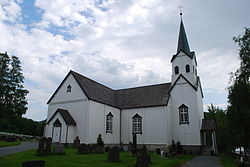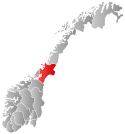Hegra (municipality)
 From Wikipedia the free encyclopedia
From Wikipedia the free encyclopedia
Hegra Municipality Hegra herad | |
|---|---|
| Hegre herred (historic name) | |
 View of the local Hegra Church | |
 Nord-Trøndelag within Norway | |
 Hegra within Nord-Trøndelag | |
| Coordinates: 63°27′50″N 11°06′51″E / 63.46389°N 11.11417°E | |
| Country | Norway |
| County | Nord-Trøndelag |
| District | Stjørdalen |
| Established | 1 Jan 1874 |
| • Preceded by | Øvre Stjørdal Municipality |
| Disestablished | 1 Jan 1962 |
| • Succeeded by | Stjørdal Municipality |
| Administrative centre | Hegra |
| Area (upon dissolution) | |
| • Total | 612 km2 (236 sq mi) |
| Population (1962) | |
| • Total | 2,704 |
| • Density | 4.4/km2 (11/sq mi) |
| Demonym | Hegrasbygg[1] |
| Time zone | UTC+01:00 (CET) |
| • Summer (DST) | UTC+02:00 (CEST) |
| ISO 3166 code | NO-1712[2] |
Hegra is a former municipality in the old Nord-Trøndelag county, Norway. The 612-square-kilometre (236 sq mi) municipality existed from 1874 until its dissolution in 1962. The municipality was located in the Stjørdalen valley. It encompassed the eastern two-thirds of the what is now the municipality of Stjørdal in Trøndelag county. The administrative centre was the village of Hegra where the Hegra Church is located.[3]
History[edit]
The municipality of Hegra was established on 1 January 1874 when the old municipality of Øvre Stjørdal was divided into Meråker (population: 1,861) in the east and Hegra (population: 3,409) in the west. During the 1960s, there were many municipal mergers across Norway due to the work of the Schei Committee. On 1 January 1962, the neighboring municipalities of Hegra (population: 2,704), Lånke (population: 1,967), Skatval (population: 1,944), and Stjørdal (population: 6,204) were all merged to form a new, larger municipality of Stjørdal.[4]
Name[edit]
The municipality (originally the parish) is named after the old Hegre farm (Old Norse: Hegrin) since the first Hegra Church was built there. The name was originally a compound of two words. The first element is named after the local river Hegra. The river name is based on the word hegri which means "heron". The last element is vin which means "meadow" or "pasture". Thus the name means something like "heron meadow".[5] Historically, the name of the municipality was spelled Hegre. On 3 November 1917, a royal resolution changed the spelling of the name of the municipality to Hegra.[6]
Government[edit]
While it existed, this municipality was responsible for primary education (through 10th grade), outpatient health services, senior citizen services, unemployment, social services, zoning, economic development, and municipal roads. During its existence, this municipality was governed by a municipal council of elected representatives, which in turn elected a mayor.[7]
Municipal council[edit]
The municipal council (Herredsstyre) of Hegra was made up of 21 representatives that were elected to four year terms. The party breakdown of the final municipal council was as follows:
| Party name (in Norwegian) | Number of representatives | |
|---|---|---|
| Labour Party (Arbeiderpartiet) | 9 | |
| Conservative Party (Høyre) | 2 | |
| Christian Democratic Party (Kristelig Folkeparti) | 2 | |
| Centre Party (Senterpartiet) | 5 | |
| Liberal Party (Venstre) | 3 | |
| Total number of members: | 21 | |
| Party name (in Norwegian) | Number of representatives | |
|---|---|---|
| Labour Party (Arbeiderpartiet) | 10 | |
| Conservative Party (Høyre) | 1 | |
| Christian Democratic Party (Kristelig Folkeparti) | 2 | |
| Farmers' Party (Bondepartiet) | 5 | |
| Liberal Party (Venstre) | 3 | |
| Total number of members: | 21 | |
| Party name (in Norwegian) | Number of representatives | |
|---|---|---|
| Labour Party (Arbeiderpartiet) | 8 | |
| Conservative Party (Høyre) | 1 | |
| Christian Democratic Party (Kristelig Folkeparti) | 2 | |
| Farmers' Party (Bondepartiet) | 5 | |
| Liberal Party (Venstre) | 4 | |
| Total number of members: | 20 | |
| Party name (in Norwegian) | Number of representatives | |
|---|---|---|
| Labour Party (Arbeiderpartiet) | 8 | |
| Christian Democratic Party (Kristelig Folkeparti) | 2 | |
| Farmers' Party (Bondepartiet) | 6 | |
| Liberal Party (Venstre) | 4 | |
| Total number of members: | 20 | |
| Party name (in Norwegian) | Number of representatives | |
|---|---|---|
| Labour Party (Arbeiderpartiet) | 9 | |
| Christian Democratic Party (Kristelig Folkeparti) | 2 | |
| Farmers' Party (Bondepartiet) | 5 | |
| Liberal Party (Venstre) | 4 | |
| Total number of members: | 20 | |
| Party name (in Norwegian) | Number of representatives | |
|---|---|---|
| Labour Party (Arbeiderpartiet) | 7 | |
| Farmers' Party (Bondepartiet) | 7 | |
| Liberal Party (Venstre) | 6 | |
| Total number of members: | 20 | |
| Note: Due to the German occupation of Norway during World War II, no elections were held for new municipal councils until after the war ended in 1945. | ||
Mayors[edit]
- 1874–1889: Olav Torsteinsen Bjørgum (V)
- 1890–1893: Mikal Setsaas (V)
- 1894–1897: John Halvorsen Øverkil (V)
- 1898-1898: Gunerius Pedersen Hofstad (V)
- 1899–1910: Ole Gundersen (H)
- 1911–1922: John Lerfald (Bp/V)
- 1923–1937: Torstein Mørseth (V)
- 1938–1941: Johan Peter Trøite (V)
- 1941-1941: Gunnar Børset (Bp)
- 1941–1944: Lars O. Setran (NS)
- 1944–1945: Anders Ingstad (NS)
- 1945-1945: Johan Peter Trøite (V)
- 1946–1947: Ole J. Hofstad (Bp)
- 1948–1951: Magne Bremseth (Ap)
- 1952–1955: Lars Bidtnes (V)
- 1956–1957: Johan Fornes (Bp)
- 1958–1959: Karl Kringen (Ap)
- 1960–1961: Jon Leirfall (Sp)
See also[edit]
References[edit]
- ^ "Navn på steder og personer: Innbyggjarnamn" (in Norwegian). Språkrådet.
- ^ Bolstad, Erik; Thorsnæs, Geir, eds. (26 January 2023). "Kommunenummer". Store norske leksikon (in Norwegian). Kunnskapsforlaget.
- ^ Askheim, Svein, ed. (20 February 2018). "Hegra". Store norske leksikon (in Norwegian). Kunnskapsforlaget. Retrieved 26 March 2018.
- ^ Jukvam, Dag (1999). "Historisk oversikt over endringer i kommune- og fylkesinndelingen" (PDF) (in Norwegian). Statistisk sentralbyrå.
- ^ Rygh, Oluf (1903). Norske gaardnavne: Nordre Trondhjems amt (in Norwegian) (15 ed.). Kristiania, Norge: W. C. Fabritius & sønners bogtrikkeri. p. 13.
- ^ "Norsk Lovtidende. 2den Afdeling. 1917. Samling af Love, Resolutioner m.m". Norsk Lovtidend (in Norwegian). Kristiania, Norge: Grøndahl og Søns Boktrykkeri: 1057–1065. 1917.
- ^ Hansen, Tore; Vabo, Signy Irene, eds. (20 September 2022). "kommunestyre". Store norske leksikon (in Norwegian). Kunnskapsforlaget. Retrieved 1 January 2023.
- ^ "Kommunevalgene og Ordførervalgene 1959" (PDF) (in Norwegian). Oslo: Statistisk sentralbyrå. 1960. Retrieved 14 April 2020.
- ^ "Kommunevalgene og Ordførervalgene 1955" (PDF) (in Norwegian). Oslo: Statistisk sentralbyrå. 1957. Retrieved 14 April 2020.
- ^ "Kommunevalgene og Ordførervalgene 1951" (PDF) (in Norwegian). Oslo: Statistisk sentralbyrå. 1952. Retrieved 14 April 2020.
- ^ "Kommunevalgene og Ordførervalgene 1947" (PDF) (in Norwegian). Oslo: Statistisk sentralbyrå. 1948. Retrieved 14 April 2020.
- ^ "Kommunevalgene og Ordførervalgene 1945" (PDF) (in Norwegian). Oslo: Statistisk sentralbyrå. 1947. Retrieved 14 April 2020.
- ^ "Kommunevalgene og Ordførervalgene 1937" (PDF) (in Norwegian). Oslo: Statistisk sentralbyrå. 1938. Retrieved 14 April 2020.
- ^ Røe, Tormod (1987). Stjørdal kommune 1837–1987. Kommunalt selvstyre 150 år (in Norwegian). Stjørdal. ISBN 8299161401.
{{cite book}}: CS1 maint: location missing publisher (link)
